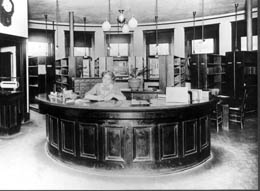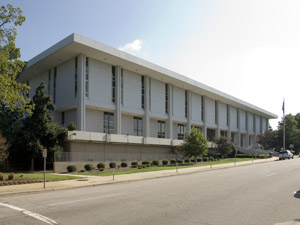
The reference desk or information desk of a library is a public service counter where professional librarians provide library users with direction to library materials, advice on library collections and services, and expertise on multiple kinds of information from multiple sources.

A library classification is a system used within a library to organize materials, including books, sound and video recordings, electronic materials, etc., both on shelves and in catalogs and indexes. Each item is typically assigned a call number, which identifies the location of the item within the system. Materials can be arrange by many different factors, typically in either a hierarchical tree structure based on the subject or using a faceted classification system, which allows the assignment of multiple classifications to an object, enabling the classifications to be ordered in many ways.

Interlibrary loan is a service that enables patrons of one library to borrow materials that are held by another library.

Digitization is the process of converting information into a digital format. The result is the representation of an object, image, sound, document, or signal obtained by generating a series of numbers that describe a discrete set of points or samples. The result is called digital representation or, more specifically, a digital image, for the object, and digital form, for the signal. In modern practice, the digitized data is in the form of binary numbers, which facilitates processing by digital computers and other operations, but digitizing simply means "the conversion of analog source material into a numerical format"; the decimal or any other number system can be used instead.

The National Library of Australia (NLA), formerly the Commonwealth National Library and Commonwealth Parliament Library, is the largest reference library in Australia, responsible under the terms of the National Library Act 1960 for "maintaining and developing a national collection of library material, including a comprehensive collection of library material relating to Australia and the Australian people", thus functioning as a national library. It is located in Parkes, Canberra, ACT.
Library collection development is the process of systematically building the collection of a particular library to meet the information needs of the library users in a timely and economical manner using information resources locally held as well as resources from other organizations. "According to is a dynamic self perpetuation cycle or process and consists six definable stages namely,community analysis, selection policies, selection, acquisition, weeding and evaluation.

The University of California operates the largest academic library system in the world. It manages more than 40.8 million print volumes in 100 libraries on ten campuses. The purpose of these libraries is to assist research and instruction on the University of California campuses. While each campus library is separate, they share facilities for storage, computerized indexing, digital libraries and management.

The Central Michigan University Libraries consists of the two libraries which support Central Michigan University, a public university in Mount Pleasant, Michigan. The CMU Libraries meets the research, information, and study needs of the students, faculty, and staff of the university, as well as researchers outside the university community. The library building is named after Charles V. Park, who was the library director at CMU from 1931 through 1957.
Library technical services are the ongoing maintenance activities of a library's collection, including the three broad areas of collection development, cataloging, and processing. Technical services are the infrastructure that enable the user's experience of many library services and are typically performed "behind the scenes."

The State Library of North Carolina is an institution which serves North Carolina libraries, state government employees, genealogists, and the citizens of North Carolina. The library is the main depository for North Carolina state publications and serves the needs of North Carolina government agencies and state government employees by providing access to information resources that are vital to public decision-making and economic development.

In conservation, library and archival science, preservation is a set of preventive conservation activities aimed at prolonging the life of a record, book, or object while making as few changes as possible. Preservation activities vary widely and may include monitoring the condition of items, maintaining the temperature and humidity in collection storage areas, writing a plan in case of emergencies, digitizing items, writing relevant metadata, and increasing accessibility. Preservation, in this definition, is practiced in a library or an archive by a conservator, librarian, archivist, or other professional when they perceive a collection or record is in need of maintenance.

Double Fold: Libraries and the Assault on Paper is a non-fiction book by Nicholson Baker that was published in April 2001. An excerpt appeared in the July 24, 2000 issue of The New Yorker, under the title "Deadline: The Author's Desperate Bid to Save America's Past". The work details Baker's project to uncover what happened to the thousands of books and newspapers that were replaced during the microfilming boom of the 1980s and 1990s. Double Fold has been a controversial work and Baker states in the preface that it is not meant to be objective: "This isn't an impartial piece of reporting". The New York Times characterized the book as a "blistering, and thoroughly idiosyncratic, exposé."

National and University Library in Zagreb (NSK) is the national library of Croatia and central library of the University of Zagreb.
Preservation survey is the process of collecting and analyzing data about the physical condition of library materials.

Mold control and prevention is a conservation activity that is performed in libraries and archives to protect books, documents and other materials from deterioration caused by mold growth. Mold prevention consists of different methods, such as chemical treatments, careful environmental control, and manual cleaning. Preservationists use one or a combination of these methods to combat mold spores in library and archival collections.
An inventory is an itemized list of objects that a museum has accessioned or received via loan(s) and must be physically located by an examiner. A complete, one-hundred percent inventory, or a random inventory of the collection should be carried out periodically to ensure the museum is operating under best practices and for security purposes. The museum is legally responsible and ethically obligated for the maintenance of up-to-date information detailing the location of all objects within the collection, including loaned items and objects that have yet to be accessioned; this is stipulated by many museum associations, including the American Association of Museums.

Keyes DeWitt Metcalf was an American librarian. He has been identified as one of the 100 most important leaders in librarianship by the journal American Libraries. In a career spanning over 75 years, he worked in various roles at the New York Public Library and served as the director of the Harvard University library system. He was known for his expertise in planning and designing research libraries.

The Younes and Soraya Nazarian Library is a central academic library of the University of Haifa, and one of the largest in Israel. It is also one of the most progressive Israeli libraries in terms of service, collection, physical space, and library information systems.

In library science and architecture, a stack or bookstack is a book storage area, as opposed to a reading area. More specifically, this term refers to a narrow-aisled, multilevel system of iron or steel shelving that evolved in the 19th century to meet increasing demands for storage space. An "open-stack" library allows its patrons to enter the stacks to browse for themselves; "closed stacks" means library staff retrieve books for patrons on request.

Weeding, also sometimes referred to as deaccession, is systematically removing resources from a library based on selected criteria. It is the opposite of selecting material for incorporation, though the selection and de-selection of material often involve the same thought process. Weeding is a vital process for an active collection because it ensures it stays current, relevant, and in good condition. Weeding should be continuous. Educating the staff with workshops and presentations on collection quality, maintenance, and the importance and positive benefits of weeding the collection are important components for a library to consider.















